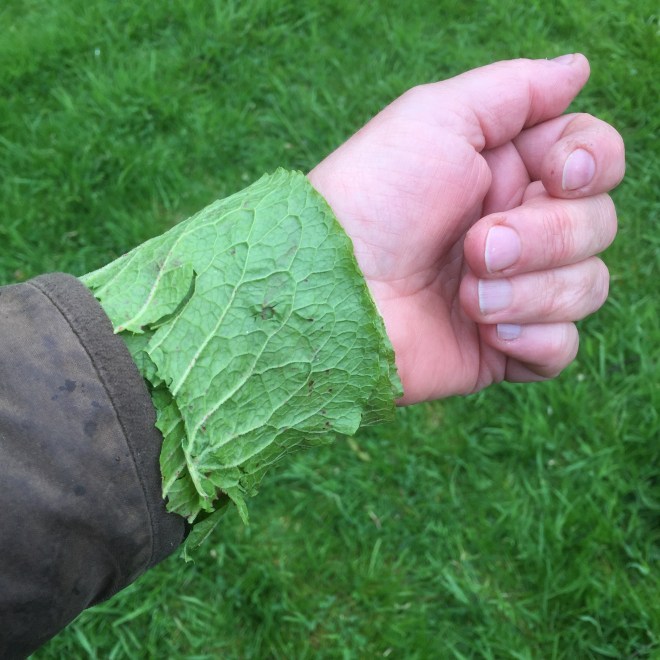The question I’m always asked on my foraging walks when talking about the common broadleaf dock is “Do dock leaves really work?”, “Do dock leaves work on nettle stings? or “Why do dock leaves work on stinging nettles?” For fun, I always ask someone in the group to demonstrate the correct use of dock leaf on a sting and, without exception, everyone just picks a large leaf, crushes it and rubs it on their sting.
This is not hugely useful. The part of the dock that really does work is the gel. You find this by going down to the centre of the plant where you’ll usually find some tightly rolled up leaf buds. If you try to pull them up, usually your hand will just slip off and you’ll come away with a papery sheath not the tasty young shoot. (That’s “tasty” in comparison to the extremely bitter mature leaves but still not a gourmet food!) However, if you go back to the shoot, you’ll find some very slippery clear gel. This is what you’re looking for when you use dock leaf to soothe nettle sting!
So do dock leaves really work? A big fat yes – provided that you use the right part. And for more that just the odd nettle sting. Foraging recently on Lambay Island I made some sugar kelp crisps which are notorious for popping in the pan. With one particular explosion I was blasted across my wrist with boiling oil. Following first aid procedure, I held by wrist under cold running water but this was not enough. My wrist had a huge raised red swelling that was starting to blister and was unbearably painful. Sadly for you, my mind was not on photographing it at that stage but on finding the right dock leaf!
i looked in shady lush woodland as out in the full sun docks produce far less gel. Sure enough I quickly found a vary large dock with large leaf sheath and a voluptuous amount of sticky gel. I smeared the gel liberally on the burn and then used the leaf sheath (gel side facing down) as a gauze dressing.
 I then removed the centre spine from a very large dry leaf, leaving the two side pieces joined at the tip, and opened it out to make a long crepe bandage. This I wrapped around my wrist to protect the dock sheath gauze and the sensitive burn, and also to prevent it drying out. I then secured it by purging an elastic hair bobble on as a ‘bracelet’ which stopped it unraveling and slipping off.
I then removed the centre spine from a very large dry leaf, leaving the two side pieces joined at the tip, and opened it out to make a long crepe bandage. This I wrapped around my wrist to protect the dock sheath gauze and the sensitive burn, and also to prevent it drying out. I then secured it by purging an elastic hair bobble on as a ‘bracelet’ which stopped it unraveling and slipping off.
 As soon as the gel was on I started to feel better. The burn cooled rapidly and the blister stopped developing. After 24 hours I took the dock dressing off and the burn looked like this third picture. Still red but no pain whatsoever even when touching it. Rubbing with pressure creates a slight ‘nip’ and that’s all. So a massive improvement and one I attribute just to that wondrous dock gel.
As soon as the gel was on I started to feel better. The burn cooled rapidly and the blister stopped developing. After 24 hours I took the dock dressing off and the burn looked like this third picture. Still red but no pain whatsoever even when touching it. Rubbing with pressure creates a slight ‘nip’ and that’s all. So a massive improvement and one I attribute just to that wondrous dock gel.
 On my foraging walks in Scotland, I also point out that when dock gel dries it is not sticky at all. In fact, your skin feels silky smooth! I joke that one day you’ll see Dock Leaf Eye Gel in our Napiers shops and when you do, you heard it here first!
On my foraging walks in Scotland, I also point out that when dock gel dries it is not sticky at all. In fact, your skin feels silky smooth! I joke that one day you’ll see Dock Leaf Eye Gel in our Napiers shops and when you do, you heard it here first!
Monica Wilde

I guess the dock is our version of the aloe.
It certainly acts the same way with stings and burns.
Thank you for this nice write up. I am always looking for local plants for first aid and medicinal use. I have aloe in the house, but I’m glad to know about the dock burn connection.
Thank you for this infomation , tips like this is always welcome & greatly appreciated. Thank you.
Dock leaves are hugely unappreciated because few people were taught how to use them properly!
To quote some wise sage (or fennel) “A picture paints 1000 words”. I seem to recall how to spot a dock leaf when I was 10 but 56 years on that vital knowledge has left my skull.
Wouldn’t it have been a great (and simple) idea to have included a picture of a Dock plant still growing, and point out the area where the prime ingredient is to be found????
What a great blog post about a plant that is often overlooked. Will be heading out at the first opportunity to try the gel. Amazing.
Kevin Bridges (Glaswegian) references Dock Leaf in
https://www.youtube.com/watch?v=fmtdRzbQVEI
at 5’45”
He is very funny. I’ve a lot of time for Kevin Bridges 🙂